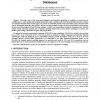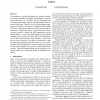29 search results - page 3 / 6 » From Sensors to Human Spatial Concepts: An Annotated Data Se... |
EMNETS
2007
13 years 10 months ago
2007
Imagers are an increasingly significant source of sensory observations about human activity and the urban environment. ImageScape is a software tool for processing, clustering, an...
SPIESR
2001
13 years 7 months ago
2001
Humans tend to use high-level semantic concepts when querying and browsing multimedia databases; there is thus, a need for systems that extract these concepts and make available a...
ECCV
2006
Springer
13 years 8 months ago
2006
Springer
Our goal is to automatically segment and recognize basic human actions, such as stand, walk and wave hands, from a sequence of joint positions or pose angles. Such recognition is d...
BMCBI
2008
13 years 6 months ago
2008
Currently, most of the discovered biological and biomedical knowledge is available as textual data in scientific papers. And, locating and curating information about a genomic enti...
SDM
2009
SIAM
14 years 3 months ago
2009
SIAM
The annotation of words and phrases by ontology concepts is extremely helpful for semantic interpretation. However many ontologies, e.g. WordNet, are too fine-grained and even hu...


